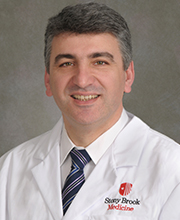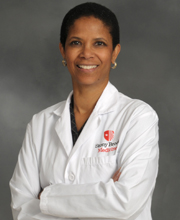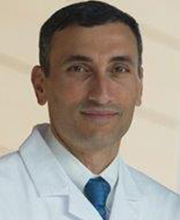The Only Center of Its Kind in Suffolk County for Patients with Aortic Conditions
The Stony Brook Aortic Center at Stony Brook Medicine provides the most focused solution to a patient's aortic disease. Our multidisciplinary team of physicians includes specialists in cardiac imaging, cardiovascular medicine, anesthesiology, cardiothoracic surgery, and vascular surgery, who work closely with each other, and with patients' referring physicians.
We are committed to providing patients with an appointment within 1 week of referral from their physician, and expediting the delivery of care.
For consultations/appointments with the surgical specialists of the Stony Brook Aortic Center Call (631) 638-1670
Aortic Center Leaders |
|
 |
Chairman, Department of Surgery
|
 |
Allison J. McLarty, MD
Associate Professor, Clinical Surgery |
 |
Associate Professor, Clinical Surgery |
| Sathappan Kumar, MD- Assistant Professor of Surgery | |
|
Ankit Dhamija, MD- Assistant Professor of Surgery |
David S. Landau, MD- Assistant Professor of Surgery |
|
Angela A. Kokkosis, MD- Associate Professor of Surgery |
Jonathan Price, MD- Assistant Professor of Surgery |
| George J. Koullias, MD, PhD- Associate Professor of surgery | Lucyna Z. Price, MD- Assistant Professor of Surgery |
To fulfill our mission of excellence in patient care, our physicians consistently take part in vascular quality initiatives that result in exceptional clinical outcomes for our patients — outcomes that rival those of some of the largest medical facilities in the northeast region of the United States.
The Aortic Center's team includes two clinical navigators who are hands-on every step of the way, to help ensure that patients and their families have the support and resources they need. Before, during, and after surgery, these navigators act as liaisons between the patient and attending physician to provide a seamless course of care.
Illustrated patient education materials are given to all patients and families to help them better understand their aortic condition and potential treatment options. After the patient's surgery, we recommend an interval surveillance regimen, and we work closely with the patient and his/her family and with the referring physician, to help ensure optimal lifelong care.
When a patient needs to be transferred to Stony Brook University Hospital, we are available 24 hours a day, seven days a week to provide immediate care. The hospital's Patient Transfer Center is a comprehensive emergency medical service system that is staffed by a team of specially-trained healthcare professionals.
Patients don't have to travel far to receive the very best in detection of and treatment for the full range of aortic conditions.
The Aortic Center, which is part of the Stony Brook Vascular Center and closely allied with the Heart Institute, is Suffolk County's only facility offering patients comprehensive and coordinated care for the full range of aortic conditions. Our sophisticated technologies — in the hands of our specialists — help define aortic problems and the optimal treatment plan. Advanced diagnostic capabilities include:
- 320-slice CT scanner for greater accuracy, faster exams, and less time needed for breath-holds.
- GE 3.0 Tesla MRI scanner for three-dimensional views of blood vessels to ensure the highest quality care and improved patient outcomes.
- PET/MRI technology that allows simultaneous scans to determine both the structure and function of aortic abnormalities.
- PET/CT scans for information about the structure and function of cells and tissues while providing greater image accuracy and shorter treatment times.
- A highly sophisticated Non-Invasive Vascular Laboratory with duplex scanners and Doppler units, used in diagnosis and follow-up.
The Aortic Center's physicians are experienced in treating patients with co-existing conditions and other high-risk factors. They offer diagnosis and treatment for all aortic diseases, including:
- Ascending, arch and descending thoracic aortic aneurysms.
- Thoracoabdominal aortic aneurysms.
- Abdominal aortic aneurysms
- Acute and chronic type A and B aortic dissections.
- Aortic root and valve disease.
- Native aortic and prosthetic graft infections.
- Aortoiliac occlusive and thromboembolic disease.
- Congenital aortic disease.
- Mesenteric and renal aneurysmal and occlusive disease.
Our minimally invasive interventions allow us to treat a wider spectrum of patients, with shorter hospital stays, and fewer postoperative complications. Our advanced interventions include:
- Endovascular stent grafts for abdominal and thoracic aortic aneurysms.
- Incisionless repair of abdominal aortic aneurysm.
- Custom-built fenestrated stent grafts to treat aneurysms with complex anatomy
- Endovascular treatment of aortic dissections.
- Valve-sparing aortic procedures.
- Visceral debranching and stent grafting for thoracoabdominal aneurysms.
- Techniques for brain and spinal cord protection during aortic procedures.
- Complex aortic re-interventions.
Aneurysms and strokes — common conditions caused by vascular disease — can strike suddenly and without warning. That’s why it’s best to identify and treat underlying causes before symptoms appear. Stony Brook Medicine offers free screenings to help detect vascular disease. Performed by a vascular technologist during a single visit and results are reviewed by a vascular surgeon. The tests include:
- Carotid ultrasound, to check for clogged carotid arteries in the neck, which can lead to stroke
- Abdominal aortic ultrasound, to test for aortic aneurysm, which can burst if reaching a large size
- Ankle-brachial index, to check for peripheral arterial disease (PAD), which may pose a threat to the health of your legs and is often a sign of heart disease
Vascular disease that affects the arteries is most often caused by atherosclerosis, a process resulting from a buildup of fatty deposits (plaque) on the inner lining of the arteries. As the buildup progresses, blood flow can become restricted or the artery may dilate and become aneurysmal.
Narrowing or blockages of arteries can occur in the arteries near the heart (cardiovascular disease), or in arteries farther from the heart, such as those in the arms, legs and the brain.
The most common forms of vascular disease are abdominal aortic aneurysms (AAA), carotid artery disease, and peripheral arterial disease (PAD) — all serious and life-threatening, often occurring "silently" without any symptoms. That's why early detection and treatment are crucial.
A Vascular Screening Could Save Your Life
The screening process for all three tests is about 10 minutes for each test and completely painless. As a service to our community, we’re offering these screening tests at no cost as just one more way Stony Brook Medicine is helping to keep you healthy.
Want to find out if you are a candidate for a free screening?
In addition to blockages, congenital disorders, and infection, two of the more common problems affecting this vessel are: aneurysms, blood-filled bulges resulting from a weakening in the vessel wall; and dissections, tears in the aorta's inner wall that can cause reduced blood supply to other parts of the body and heart failure.
These problems can occur in anyone, but most patients are male, over age 55, smoke tobacco, and have high blood pressure or heart disease.
One of the goals of the Aortic Center is to educate patients and provide primary care providers with resources that facilitate early recognition of patients at risk, timely diagnosis of aortic conditions that are often silent, and medical control of risk factors so that we reduce the number of aortic emergencies in our area.

